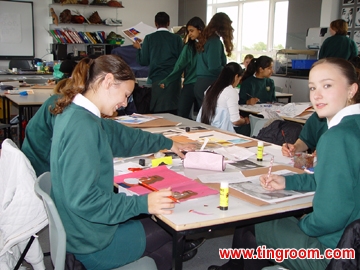听播客学英语 175 去中学(在线收听)

In England, children normally start school when they are about five. They go to a primary school until they are 10 years old. Then they move to secondary school. This is big change for children. Secondary schools are much bigger than primary schools. Many children have to travel to secondary school on a bus or a train. There are new teachers and new subjects. And many unfamiliar faces.
The move to secondary school is sometimes a big problem for parents too. Which secondary school will their children go to? In theory, parents can choose a school for their children. But some schools are very popular – for example, schools with good exam results, or good facilities – and others are not popular – for example, schools with poor exam results, or where the behaviour of the pupils is bad. In some secondary schools, there are not enough places for all the children who would like to go there. So there needs to be a way of deciding which children get places in the most popular schools and which do not.
The most common way of allocating school places is to offer places first to children who already have an older brother or sister in the school, and then to children on the basis of how close to the school they live. In many parts of England, this system works well. But it can lead to schools in nice white middle class areas recruiting only nice white middle class children, while children from poorer social backgrounds go to other schools. Well-off parents can afford to buy a house close to a good school, to make sure that their children get places there; less well-off parents may not be able to do this. The result, some people say, is too much social segregation – white middle class children at one school, poorer children at another. It is rather similar to the problem in many American cities of racial segregation in schools – some schools almost entirely white, others almost entirely black.
Are there any alternatives? At one time, children in Britain sat an exam in their last year at primary school. It was called the “eleven-plus” exam, because it decided which school children could go to from the age of 11. Children who did well in the exam went to schools called grammar schools, which offered an academic education. Children who did not pass the exam went to secondary modern schools, which offered a less academic and more practical education. This system still survives in place in England – including here in Birmingham. In theory, places in grammar schools are offered to pupils on merit, without regard to their social background, or how far from the school they live. In practice, however, middle class parents pay private tutors to prepare their children for the grammar school exams. The grammar schools are largely middle class schools and take only a few children from poorer families.
There are also faith schools in England. These are schools in the state school system which are run by a religious group. Most of them are Roman Catholic or Church of England schools, though there are some Jewish and Moslem schools as well. So, Roman Catholic schools offer places first to children from Catholic families, and only accept children who are not Catholics if they have places left. And similarly with other faith schools. Many faith schools are good schools, and some middle class parents “get religion” in order to get a place for their child at a faith school.
The problem has been in the newspapers this week because in two places in England, the local authority has decided to that places at secondary schools will be offered by lottery – in other words, the schools will offer places at random. It will no longer be important to live close to the school, or to pass an exam, or to go to church regularly. If you are lucky in the lottery, your child will get a place at a good school. If you are unlucky, they will not. This is very controversial. Will it be a good system for allocating places in good, popular schools? We shall have to wait and see.
Picture is of girls at Swanshurst School, Birmingham where my daughter goes to school